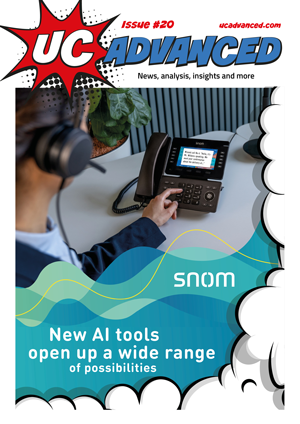Students have returned to classrooms, right?
So is there any advantage to learning about education for the UC&C industry?
After years of half terms and summer holidays where parents trudged off to work whilst the children stayed at home, the shoe is on the other foot!
While the kids are putting on uniforms and commuting everyday, the grown ups have the option to stay at home for the majority of the week; in what can only be described as the smallest of victories!
Of course it was inevitable that pupils would return to the classroom. But that doesn’t mean that collaboration platforms have become obsolete overnight, as Jed Macosko, Professor of Physics at Wake Forest University, points out, Teams and Zoom are great for enabling “virtual office hours, virtual internships, and virtual classes on snow days.
“All three of those areas are perfect use cases for collaboration tools. Now that the world has seen how easy it is to have a virtual summer intern as compared to someone in-person, or how easy it is to hold online office hours instead of actually being in one’s office, it’s hard to go back to the old ways.”
Those “old ways” are unlikely to return too, as the importance of connectivity within schools was one of the “wake up calls” that educational institutions across the country felt according to TP-Link Business Development Manager and education specialist, Martin McDermott.
“The pandemic kicking in really started to open up lots of communication issues that schools had. Obviously they needed to put something in place for the students to be taught remotely and it really did become very evident that they were not ready for the pandemic.
“As a result, the Department for Education realised a lot of schools didn’t have the good strong WiFi networks to facilitate this type of distance learning and collaboration, and put in place another programme called Connect the Classroom which offers £150 million of funding for specific schools within deprived areas across the UK.
“What we are doing is we’re working with those schools that have a need for upgrading their WiFi solutions, and therefore produce more collaborative learning and educational needs for the students. We still see the need for a really good strong WiFi network across schools, so that the teachers can deliver engaging lessons and be collaborative with their peers.”
Role of trust
While the usage of collaboration platforms may have taken a dive in the classroom, it hasn’t gone away completely.
As more schools become incorporated into Academic Trusts, video conferencing enables communication between those schools for both teachers and pupils to learn and better the education experience.
“With schools coming together under Multi Academy Trusts (MATS) there’s potentially lots of teachers that could be roaming between different schools delivering lessons,” said McDermott.
“As more schools join these trusts, teachers are realising they can teach a class remotely in another school as well as in person. Therefore they want seamless connectivity between schools.”
Chris Southern, General Sales Manager of Enterprise solutions at Midwich built on McDermott’s point, adding that the introduction of video since the turn of the decade has enabled these intra-school classes.
“Before the pandemic, teachers wouldn’t consider putting a camera in a classroom; the fear of filling in forms would be enough of a deterrent,” said Southern. “But today the ability to say ‘let’s call our other school and bring some of the kids in from that class’ is seen as a positive by lots of teachers.
“Lots of schools and units within the schools are paired with schools in different countries now, so they have the ability to bring in another school in Africa, for example, and share the lesson with kids from a different continent.”
Innovative Teaching
Although kids have always been more technologically savvy than teachers, that exposure to technology from a young age has meant that keeping the kids engaged can become a task.
That challenge of engagement is something Southern says is getting better as younger teachers, who are open to using technology in different ways, join the workforce.
“Teachers have finally started to understand that, if you want to collaborate with the students in the room, better experiences get better responses and higher retention levels.
“We’ve also got to remember that these children have an iPhone, iPad, PS5 at home, and even the telly downstairs is a smart TV. Their world revolves around collaborative information around video, voice and imagery, so if you sit them down in a room, talk at them, and put a book in front of them, you’re going to have limited success because they’ve got the retention of a goldfish!”
As we all learn in different ways, making lessons engaging and, on occasion, entertaining can often make subjects easier for students to grapple with. McDermott added that those teachers who have adapted their approach are able to deliver much more engaging lessons.
“Generally you get a couple of different teacher types, young teachers that are really engaging with technology, and the mature teachers that would be frightened of engaging in new technologies because they don’t know what to do if it goes wrong.
“Virtual Reality and Augmented Reality platforms and tools need to be easy to use and work well the first time, because the content there is strong and engaging for the classroom. But if the person at the front of the class doesn’t feel comfortable using it, it’s useless.
“If you’ve got a young, engaging person that’s not frightened of technology, they will look at new technologies, test out the experience, and want to work with it to see how it can improve their lessons. Mature teachers were reluctant to accept change but have started to adopt and accept that that change is here to stay now.”
Surrounded by Tech
As teachers continue to realise the engaging ways lessons can be taught throughout the curriculum, we may be tempted to credit this trend to the events of 2020.
However Southern warned against this, adding that the new wave of teachers coming in who understand technology, and are using IT to create more engaging lessons, is the driving factor.
“I used to spend hours of my time training teachers and I’d go back three months later and train the same people again on the same stuff, because they just weren’t going to use it. Teachers have got a lot better at using touch and inking tools. I think that’s because a lot of these teachers have iPads and they’re used to technology at home.
“Programmes like Word, PowerPoint, Excel, OneNote all have inking tools built into them, so teachers can use the native tools on their laptop that they use every day, but take advantage of the inking tool. In the modern school and college, all the content is software so what they need in the room is a big version of their laptop so they can show it to the whole group and work on it with inking tools.
“So, when we install a new interactive touchscreen in a classroom and give the teachers the opportunity to play around with it, they know exactly how to use it, how to connect their laptop, how to write on it, and we don’t have to repeat any training again.”
This engagement goes beyond inking tools, as McDermott says, embracing VR and AR solutions can bring subjects to life; literally!
“There’s one particular company called Class VR who have a very good platform that shows teaching and learning content for teachers across the world.
“So if a teacher had a lesson about the pyramids in the Middle East, they could show the class what that looked like, how they could get inside the pyramid itself, all through VR headsets. That’s an engaging lesson that kids love, and they’ll take away a lot from that experience without even leaving the classroom.”
Challenges for collaborations
As we move forward, the likes of Teams and Zoom still have a hand in the education landscape.
In the corporate world, being able to use these platforms and be comfortable in front of a screen is imperative in the pursuit of success, so normalising them to students can be seen as a positive.
Macosko added that this idea of introducing students to collaboration platforms early also plays into the vendor’s hands.
“Collaborations such as Zoom and Teams were not necessarily destined to have a long-term role in education. If the pandemic hadn’t hit when it did, there could have been other collaboration tools that took their place and would have slowly captured the usage of people in education.
“However, given how well-positioned these platforms were when the pandemic hit, it seems these tools have long-term staying power in education, and now they are pivoting to provide custom-use features.
“For example, Zoom is making good use of the fact that students became comfortable with its platform in virtual classrooms, by attracting some of those same students, who are now in the workforce, to use its platform for business.”
Despite the apparent opportunism from the vendors, Southern pointed out that the use of these platforms isn’t all bad, and does prepare students for the real world; one of the primary functions of education.
“Since COVID, technology adoption has accelerated within the workplace. Before the pandemic we were talking about remote working but the problem was not the technology, it was getting people to learn and adapt to it.
“If schools are going to prepare kids for the real world, they need to be able to use Teams and Zoom because we now have a complete industry, whether you’re in nursing, teaching, law or finance, who now are quite comfortable using a video call.”











